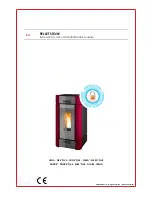
OPERATING INSTRUCTIONS
®
charnwood
I
I S L A N D
III
II
Fig. 8. Throat Plate
REFUELLING
Keep the firebox filled up to the level of the air holes in the back
firebrick, but do not overfill to prevent fuel from spilling over the top
of the front fire bar. Logs should be evenly distributed, filling the
firebed to give the most pleasing flame pattern. The air control must
be fully opened after refuelling until the flames are established above
the fire. It is best to refuel on to a hot bed of ash. If at this point the
fire starts to die, the doors must be cracked open until the fire is
revived in order that smoke may not be produced. If the fire has
started to die down before refuelling, then more kindling wood must
be added, the air control opened fully and the door cracked open to
re-establish the firebed
before
adding larger logs.
Care should be taken especially when burning wood that fuel does
not project over the front fire bar or damage to the glass may be
caused when the doors are closed. It can also cause the glass to
blacken. Maximum filling height is such that logs cannot fall from the
fire when the doors are opened. Liquid fuels are not to be used on
this appliance.
MAINTENANCE
Cleaning
The stove is finished with a high temperature paint which will
withstand the temperatures encountered in normal use. This may be
cleaned with a damp lint-free cloth when the stove is cold. Should re-
painting become necessary then special high temperature paints are
available from your supplier or from Charnwood.
Cleaning the Glass
The glass in the doors is a special ceramic glass which is able to
withstand high temperatures. Before cleaning the glass open the
doors and allow them to cool. Clean the glass using a damp cloth and
then wipe over with a dry cloth. Any stubborn deposits on the glass
may be removed with a proprietary stove glass cleaner or ceramic
hob cleaner. Some deposits on the glass may be burnt off simply by
running the fire at a fast rate for a few minutes. Do not use abrasive
cleaners or pads as these can scratch the surface which will weaken
the glass and cause premature failure. Aerosol spray cleaners should
not be used near the appliance whilst it is under fire.
When Not in Use
If the fire is going to be out of use for a long period (for instance in
the summer) then to prevent condensation, and hence corrosion,
the air control should be left fully open and the fire doors left ajar. It
is also advisable to sweep the chimney and clean out the fire.
Spraying the inside of the doors and firebox with a light oil, such as
WD40, will also help to keep all internal parts working well.
After long periods where the fire has been out of use, the chimney
and appliance flueways should be cleaned before lighting.
Door Seals
For the fire to operate correctly it is important that the door seals
are in good condition. Check that they do not become worn or
frayed and replace them when necessary.
Servicing
It is recommended that the fire is serviced once a year to keep it in
first class working order. After cleaning out the firebox thoroughly,
check that all internal parts are in good working order, replacing any
parts that are beginning to show signs of wear. Check that the doors
seals are in good condition and that the doors seal correctly. A
servicing guide is available on request. Repairs or modifications may
only be carried out by the Manufacturer or their approved agents.
Use only genuine Charnwood replacement parts.
THROAT PLATE AND
FLUEWAY CLEANING
It is important that the throat plate and all the stove flueways are
kept clean. They should be checked approximately once a week, by
looking up into the firebox for signs of soot or fly-ash on the throat
plate and at the sides of the firebox. If there are signs of a build up of
soot or fly-ash deposits then the fire must be let out in order to
clean the throat plate and flueways.
Before attempting to clean the throat plate and flueways, ensure that
the fire is cold. Wear suitable gloves to prevent irritation from soot
deposits. To remove the throat plate lift the front edge up and slide
the plate forward until it comes clear of the front pegs, then swing
the front edge down (see Fig. 8).
Lift throat plate at
front, then pull forward
and swing down.
5






































